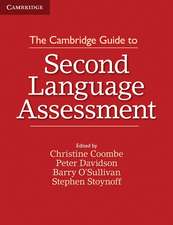Solving the Achievement Gap: Overcoming the Structure of School Inequality
Autor Stuart S. Yehen Limba Engleză Paperback – 23 dec 2016
This book examines the cause of the student achievement gap, suggesting that the prevailing emphasis on socioeconomic factors, sociocultural influences, and teacher quality is misplaced. The cause of the achievement gap is not differences in parenting styles, or the economic advantages of middle-class parents, or differences in the quality of teachers. Instead, schools present learning tasks and award grades in ways that inadvertently undermine the self-efficacy, engagement, and effort of low-performing students, causing demoralization and exacerbating differences in achievement that are seen to exist as early as kindergarten. This process systematically maintains and widens initial gaps in achievement that might otherwise be expected to disappear over the K-12 years. Misdiagnosis of the nature of the achievement gap has led to misguided solutions. The author draws upon a range of research studies to support this view and to offer recommendations for improvement.
<
| Toate formatele și edițiile | Preț | Express |
|---|---|---|
| Paperback (1) | 221.06 lei 6-8 săpt. | |
| Palgrave Macmillan US – 23 dec 2016 | 221.06 lei 6-8 săpt. | |
| Hardback (1) | 588.04 lei 6-8 săpt. | |
| Palgrave Macmillan US – 23 dec 2016 | 588.04 lei 6-8 săpt. |
Preț: 221.06 lei
Nou
Puncte Express: 332
Preț estimativ în valută:
42.31€ • 43.60$ • 35.72£
42.31€ • 43.60$ • 35.72£
Carte tipărită la comandă
Livrare economică 01-15 martie
Preluare comenzi: 021 569.72.76
Specificații
ISBN-13: 9781137587664
ISBN-10: 1137587660
Pagini: 247
Ilustrații: XII, 240 p.
Dimensiuni: 155 x 235 x 13 mm
Greutate: 0.36 kg
Ediția:1st ed. 2017
Editura: Palgrave Macmillan US
Colecția Palgrave Macmillan
Locul publicării:New York, United States
ISBN-10: 1137587660
Pagini: 247
Ilustrații: XII, 240 p.
Dimensiuni: 155 x 235 x 13 mm
Greutate: 0.36 kg
Ediția:1st ed. 2017
Editura: Palgrave Macmillan US
Colecția Palgrave Macmillan
Locul publicării:New York, United States
Cuprins
Acknowledgements.- Introduction.- Chapter 1: Hypotheses.- Chapter 2: A Fresh View.- Chapter 3: Evidence from Three National Studies.- Chapter 4: A New Model of Learning.- Chapter 5: Contradictions Resolved.- Chapter 6: Consequences for Minorities.- Chapter 7: No-Excuses Charter Schools.- Chapter 8: Better Teachers.- Chapter 9: 22 Strategies.- Chapter 10: Solving the Achievement Gap.- Conclusion.
Notă biografică
Stuart S. Yeh is Associate Professor of Evaluation Studies at the University of Minnesota, USA. He has published numerous scholarly articles and two books regarding promising strategies for addressing the achievement gap, and has served as an invited expert at the Organisation for Economic Co-operation and Development.
Textul de pe ultima copertă
This book examines the cause of the student achievement gap, suggesting that the prevailing emphasis on socioeconomic factors, sociocultural influences, and teacher quality is misplaced. The cause of the achievement gap is not differences in parenting styles, or the economic advantages of middle-class parents, or differences in the quality of teachers. Instead, schools present learning tasks and award grades in ways that inadvertently undermine the self-efficacy, engagement, and effort of low-performing students, causing demoralization and exacerbating differences in achievement that are seen to exist as early as kindergarten. This process systematically maintains and widens initial gaps in achievement that might otherwise be expected to disappear over the K-12 years. Misdiagnosis of the nature of the achievement gap has led to misguided solutions. The author draws upon a range of research studies to support this view and to offer recommendations for improvement.
<
Caracteristici
Builds on voluminous research in order to explain the persistence of the achievement gap in schooling today Draws upon well-established research from top scholars in the field Contradicts existing theories that the achievement gap is a product of sociocultural and socioeconomic differences that exist among children prior to entering the school system









